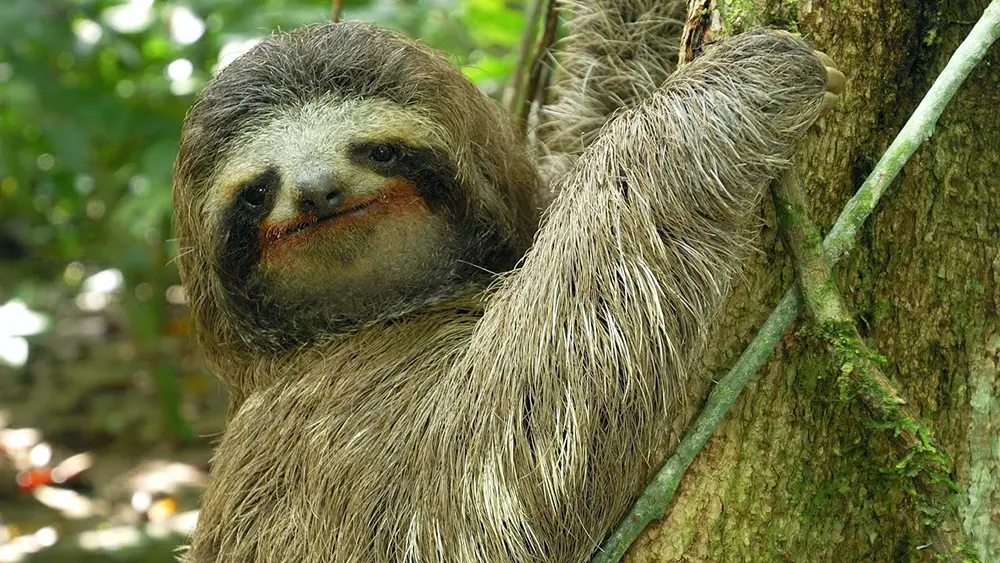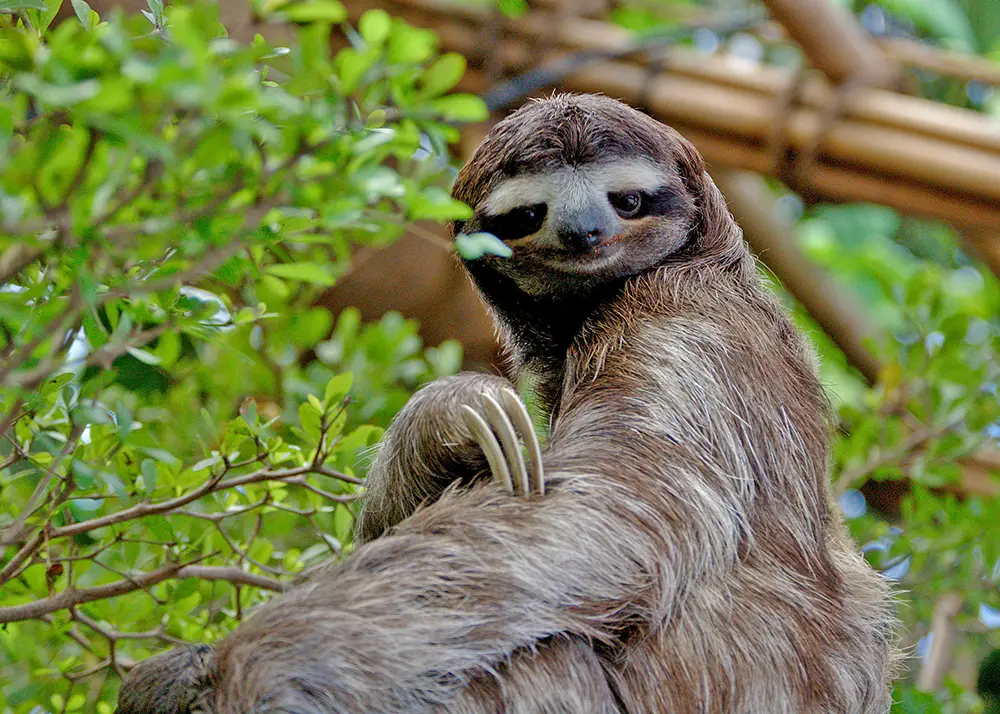Sloths are loved by lots of people thanks to their adorable looks. However, there’s a lot more to them than their cute features.
To get to know them better, here are 20 interesting facts about sloths.

1. What is a sloth and why do they hand upside down?
The sloth is a slow-moving mammal that spends most of its life hanging upside down in the trees of the tropical rainforests of Central and South America. Since they’re so slow, they can’t run away from predators. So, hanging below branches makes them less visible to eagles and their claws can grip the branch without using any energy. Sloths spend so much time upside down that their fur lies the opposite way to most mammals, growing from the paws up to the body.
2. International Sloth Day Celebration
International Sloth Day was created by AIUNAU, a non-profit foundation dedicated to protecting all forms of wildlife. It is celebrated yearly worldwide on October 20th. International Sloth Day was established in November 2010 as a way of helping people get to know a little bit more about these animals and keep them from going entirely extinct, as has happened to several species of sloths.
3. The diet of a sloth
Sloths are mostly herbivorous, but they may occasionally snack on larval insect, small lizards or other protein-packed snacks (such as bird eggs). That’s why sometimes they’re considered omnivores. But their diet mainly consists of leaves, fruit and some select fresh green shoots. They lap dewdrops off of leaves and fruits, and get additional water from their food.
4. Sloths have a low metabolic rate and a low body temperature
This keeps their food and water needs to a minimum. Therefore, the digestive process can take as long as a month or more to complete. Their metabolic rates are less than half of that expected for a creature of their size. Sloths maintain a low body temperature even when active, somewhere between 30 to 34 degrees Celsius (or 86 to 93 degrees Fahrenheit). When resting, their temperature is even lower by a few degrees.
5. There are two main species of sloths
Sloths are classified by the number of claws on their front feet (two or three). The two species have similar features: roundish heads, sad-looking eyes, tiny ears, and stubby tails. However, two-toed sloths are slightly bigger and tend to spend more time hanging upside-down than the three-toed ones, who will often sit upright in the fork of a tree branch. Also, three-toed sloths have facial coloring that makes them look like they’re always smiling.
LEARN MORE: 10 Facts About the Gray Langur, India’s Terrestrial Monkey
6. What’s the sloth’s main predator?
The jaguar, the harpy eagle and humans are the biggest dangers to a sloth. The majority of sloth deaths in Costa Rica are from contact with electrical lines and from poachers. Their claws also provide a further unexpected deterrent to human hunters – when hanging upside-down in a tree they are held in place by the claws themselves and often do not fall down even if shot from below.
7. The ‘ancient’ sloth
The modern sloth is usually around the size of a medium-sized dog. But ancient sloths of years ago, known as ‘Megatherium’, could grow as large as an Asian elephant. These huge sloths sometimes featured areas of small bone discs that would act as ‘armour plating’ for protection. They became extinct around 10,000 years ago.
8. The reproduction of sloths
All sloths are solitary by nature, and come together only to mate. Adult females produce a baby per year. However, there are some cases when their lack of movement keeps females from finding males for longer than one year. They give birth upside down hanging from a tree branch. Although they can breed year-round, most mating occurs toward the end of the rainy season and at the very beginning of the dry season, when food is most plentiful. Two-toed female sloths are pregnant for nearly a year. Three-toed sloths have a gestation period only half as long.
9. Sloths have an extra vertebrae at the base of their neck
This special feature enables them to obtain an almost 360° view of their surroundings, which proves to be a highly beneficial defensive mechanism. The extra vertebrae makes sloths stand out from other mammals whose bone structures do not allow this amazing flexibility.
10. The behaviour of sloths
Sloths spend most of their lives hanging upside-down from tree branches. They eat, sleep, mate and give birth upside-down in the trees. Male sloths are solitary, shy animals.
Sloths are nocturnal, so they are most active at night and sleep all day. They rarely come down from the trees. About once every week, they descend to go to the “bathroom,” slowly moving about by digging their front claws into the dirt and dragging their bodies.

11. Sloths don’t have good eyesight
Sloths aren’t exactly known for their sharp senses, especially when it comes to their eyesight. For example, a mama three-toed sloth can’t spot her own baby from 5 feet away. Probably, the reason behind this is a genetic mutation. Three-toed sloths are born without cone cells in their eyes, which are needed to detect colors. As a result, they see things in black and white, and in poorer resolution as well. They also have a hard time handling bright lights.
12. Sloths are strong swimmers
They will sometimes drop down from their treetop perches into water and use their extended arms to propel through water. This might seem like a useless adaptation, since sloths aren’t adapted to an aquatic lifestyle. However, living in the tropical rainforests of Central and South America, swimming can actually be very helpful. Water levels frequently rise and flooding can occur, which means swimming is a basic survival skill.
13. Sloths are very strong
Despite having 30% less muscle mass compared to other similar-sized mammals, they can easily suspend their entire body weight from a single limb, holding it at a 90-degree angle for over ten minutes. They can hold the crucifix position, suspended between two tree branches for extraordinary lengths of time and their grip strength can withstand the force of a harpy eagle trying to rip them from the tree.
14. Green algae grows on their fur
More than half of all sloths harbor algae, because of their slow pace. It gives their coarse, brownish-gray coats a greenish hue during the rainy season. Surprisingly, the existence of algae on their fur works to the sloth’s advantage. This color works as camouflage and helps them blend in among the trees.
15. Sloths’ closest relatives are anteaters and armadillos
Together, sloths, anteaters and armadillos, belong to an ancient group of mammals called the “Xenarthra”. They evolved in isolation around 80 million years ago when South America was still an island. Xenarthrans share several characteristics not present in other mammals, which suggests that their ancestors were subterranean diggers for insects.
16. Baby sloths spend a lot of time with their mothers
After they are born, baby sloths cling to their mother’s belly until they are able to feed themselves. This can take anywhere from five weeks to six months. Even after they stop dangling from their mother, little sloths stay by her side for two to four years, depending on the species. For most species of sloth, females mature faster than male sloths. For example, female two-toed sloths typically reach sexual maturity at approximately 3 years of age, while males mature at 4 to 5 years of age. However, the reverse is true for the three-toed sloth.
17. A sloth’s teeth grow continuously throughout its life
Thanks to chomping on plants, their teeth get worn down, which prevents them from getting too long. For a long time, it was thought that sloths did not have teeth. However, they do have teeth, but a small number. Sloths have only10 upper teeth and 8 lower teeth. The most prominent are the two front teeth that they use to bite off their food. Their other teeth are flat and are used for grinding up their food.
18. What does a sloth sounds like?
Lots of people are wondering what a sloth sounds like… It’s apparently a bit like the hiss of a deflating balloon. It also can squeal and grunt.
19. The reason behind why they’re so slow
As mentioned before, sloths have leafy, low-calorie diets and very slow metabolisms to match. Because of this specialized metabolism, they need to be frugal with their energy use. Therefore, they move slowly and tend not to wander far from their small home ranges. At the same time, they have very long arms, but very short shoulder blades, allowing them to have a large reach with very little movement. That lets them save energy while making the same movements as other animals.
20. Having a sloth as a pet is not a good idea
Sloths may be cute, but they don’t make good pets. Due to their unique diet, lifestyle and health needs, they require specialized care. Instead of adopting a sloth, you can opt for better ways to help them, such as donating to special organizations that fight for their protection.
Thanks to their big number of amazing features, everyone can agree that sloths are unique and should be appreciated more.
Watch the video presentation about sloths:
Check out my YouTube Channel for more educational videos!
References: Sloth Appreciation Society, How It Works Daily, Days of the Year, Smithsonian’s National Zoo, Animal Corner, National Geographic Kids, Pets on Mom, Mental Floss, Roaring Earth, The Conservation Foundation, Live Science, Wikipedia, KidZone, Sleep Better, WikiWand


